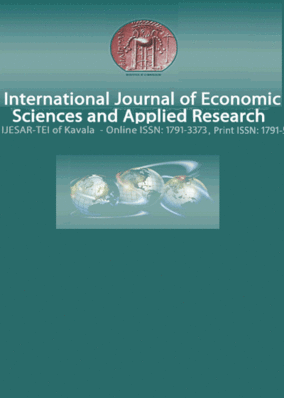Infrastructure, knowledge and economic growth in China : 1953-2004
Part of : International journal of economic sciences and applied research ; Vol.5, No.1, 2012, pages 23-50
Issue:
Pages:
23-50
Author:
Abstract:
This paper evaluates the economic development of China using the New Economic Geography (NEG) as a framework of analysis. The NEG addresses the formation of agglomeration economies accruing to physical linkages in one location leading to the formation of a core periphery pattern between the regions of a country. However, the NEG cannot account for the role of knowledge creation linkages which are location independent in the formation of the core-periphery pattern. The main findings of this paper are that the formation of the coreperiphery pattern predicted by the NEG depends upon government economic and development policy at a point in time. Furthermore, while the NEG does not allow for knowledge creation to be involved in the formation of the core-periphery pattern, this paper shows that once the core-periphery pattern is formed, the knowledge creation process sustains it. This paper also supports the hypothesis that investment in infrastructure and fixed assets, which has been concentrated in China due to the nature of the Special Economic Zones in the Coastal regions, and the interdependence between different types of infrastructure leads to the formation of the core-periphery pattern.
Subject:
Subject (LC):
Keywords:
income disparity, infrastructure, knowledge creation, China
Notes:
Περιέχει διαγράμματα, πίνακες και βιβλιογραφία
References (1):
- Beijing Review, 1997, ‘Lower Unemployment Rate a Top Priority’, 40, 35, pp. 1-7.Li,B., and Piachaud, D., 2004, ‘Poverty and Inequality and Social Policy in China ’, CasePaper 87, November 2004, Centre for Analysis of Social Exclusion, LSE, pp. 1 -49.Chan, R. C. K., 1996, ‘Regional Development of the Pearl River Delta Region under theOpen Policy’, Chan, R.C.K., Xue, T., Luk, C., China's Regional Economic Development ,CUHK, pp. 305-321.Chang, G.H., 2002, ‘The cause and cure of China’ s widening income disparity’, ChinaEconomic Review, 13, pp. 335-340.Fan, C.C., 1995, Of belts and Ladders: State Policy and Uneven Regional DevelopmentinPost-Mao China’, Annals of the Association of American Geographers, 85, 3, pp.421-449.Kai-Ming, C., 1998, ‘Reforms in the Administration and Financing of Higher Education’,Agelasto, M. and Adamson, B., Higher Education in Post-Mao China, Hong KongUniversity Press, pp. 1-492.Krugman, P., 1991, ‘Increasing Returns and Economic Geography’, The Journal of PoliticalEconomy, 99, 3, pp. 483-499.Kwan, C.H., 2007, ‘China Shifts from Labor Surplus to Labor Shortage ’, China inTransition, September 2007, http://www.rieti.go.jp/en/china/07091101.html , (accessed09/09/2010).Kwok, R., 1986, ‘Structure and Policies in Industrial Planning in the Shenzhen SpecialEconomic Zone,’ Jao, Y. and Leung, C., China’s Special Economic Zone: Policies,Problems and Prospects, OUP, pp. 39-64.Lai, H., 2002, ‘China’s Western Development Program: Its rationale, Implementation andProspects’, Modern China, 28, 4, pp. 432-466.Lin, G., 1999, ‘Transportation and Metropolitan Development in China’s Pearl River Delta:The Experience of Panyu’, Habitat Inti, 23, 2, pp. 249-270.Naughton, B., 1988, ‘The Third Front: Defence Industrialisation in the Chinese Interior ’,The China Quarterly, 115, pp. 351-386.NBSC., 2006, Compendium of Statistics 1949-2004, National Bureau of Statistics of China,Beijing.Qian, D., Pong, R., Yin, A., Nagarajan, K. and Meng, Q., 2009, ‘Determinants of health caredemand in poor, rural China: the case of Gansu province ’, Health Policy and Planning,24, pp. 324-334.Ramesh, S., 2010, ‘Continental Drift: China and the Global Economic Crisis’, Wang, L.,Rising China in the Changing World Economy, Routledge/Taylor and Francis Group,forthcoming, January 2012.Ravallion, M. and Jalan, J., 1999, ‘China ’s Lagging Poor Areas’, American EconomicReview, 89, 2, pp. 301-305.Ravallion, M., 2002, ‘Externalities in Rural Development: Evidence for China’, WorldBank Policy Research Working Paper 2879, World Bank, pp. 1-40.Riskin, C., 1987, ‘'China’s Political Economy: The Quest for Development Since 1949',OUP, Oxford, pp. 1-418.Rosenberg, N., 2004, Innovation and Economic Growth, OECD, pp. 1-6.Straub, S., 2008, Infrastructure and Growth in Developing Countries: Recent Advancesand Research Challenges, Policy Research Working Paper 4460, World Bank, pp. 1 -54.Tracy, N., 1997, ‘The South East: The Cutting Edge of China’s Economic Reform’, Linge,L., China s New Spatial Economy: Heading Towards 2020, OUP, pp. 72-97.Veeck,G., 1991, ‘Preface’, Veeck, G., The Uneven Landscape: Geographical Studies inPost- Reform China, Geosciences Publications, Louisiana State University, pp. 1-269.Yin, R.K. ., 2003, Case Study Research: Design and Methods, 3rd Edition, Sage Publications,London.




